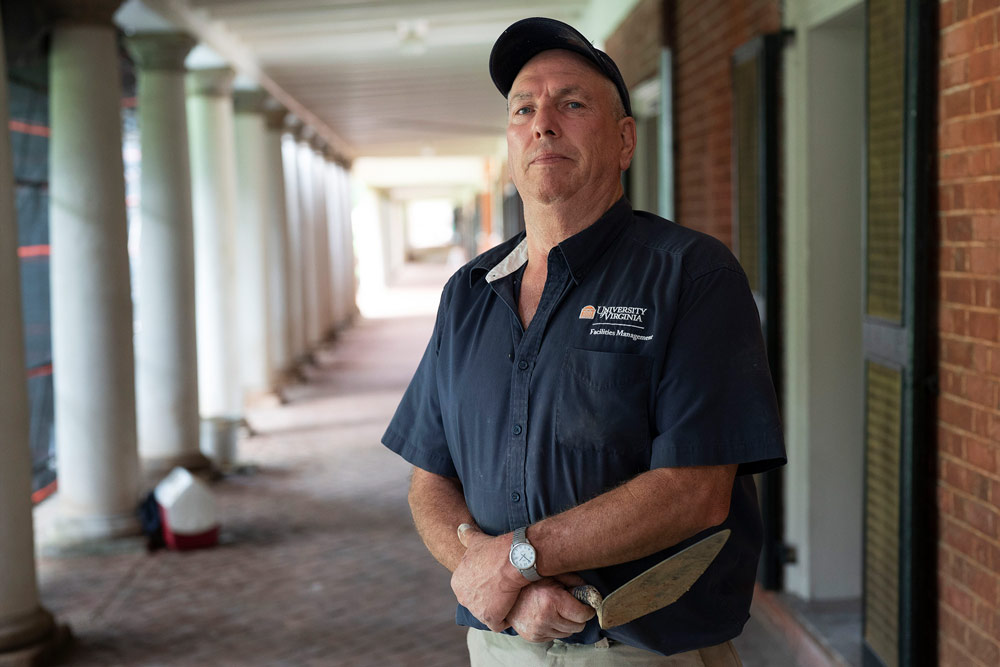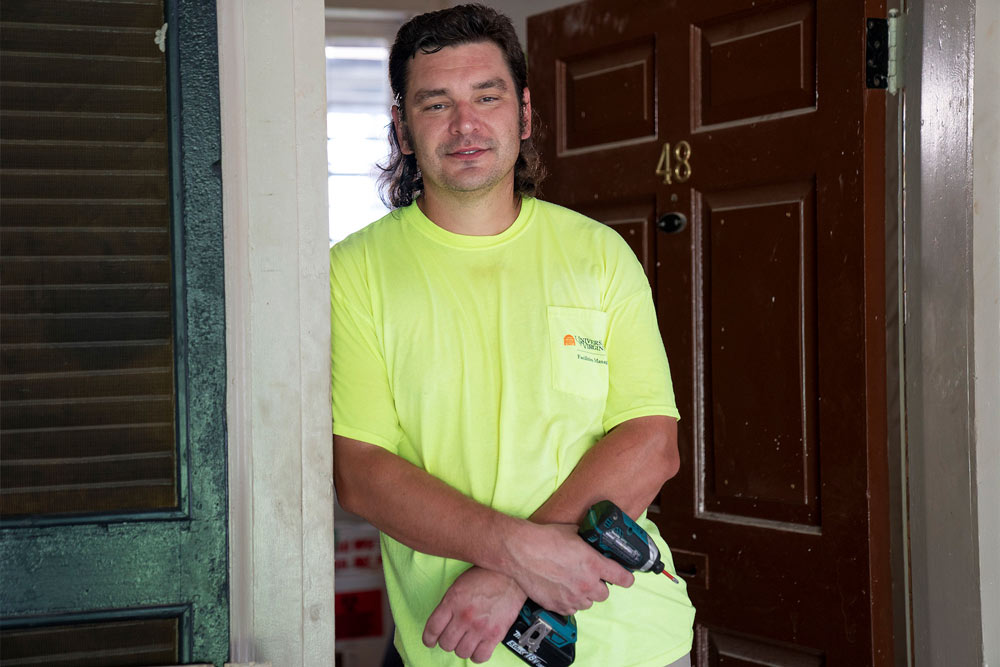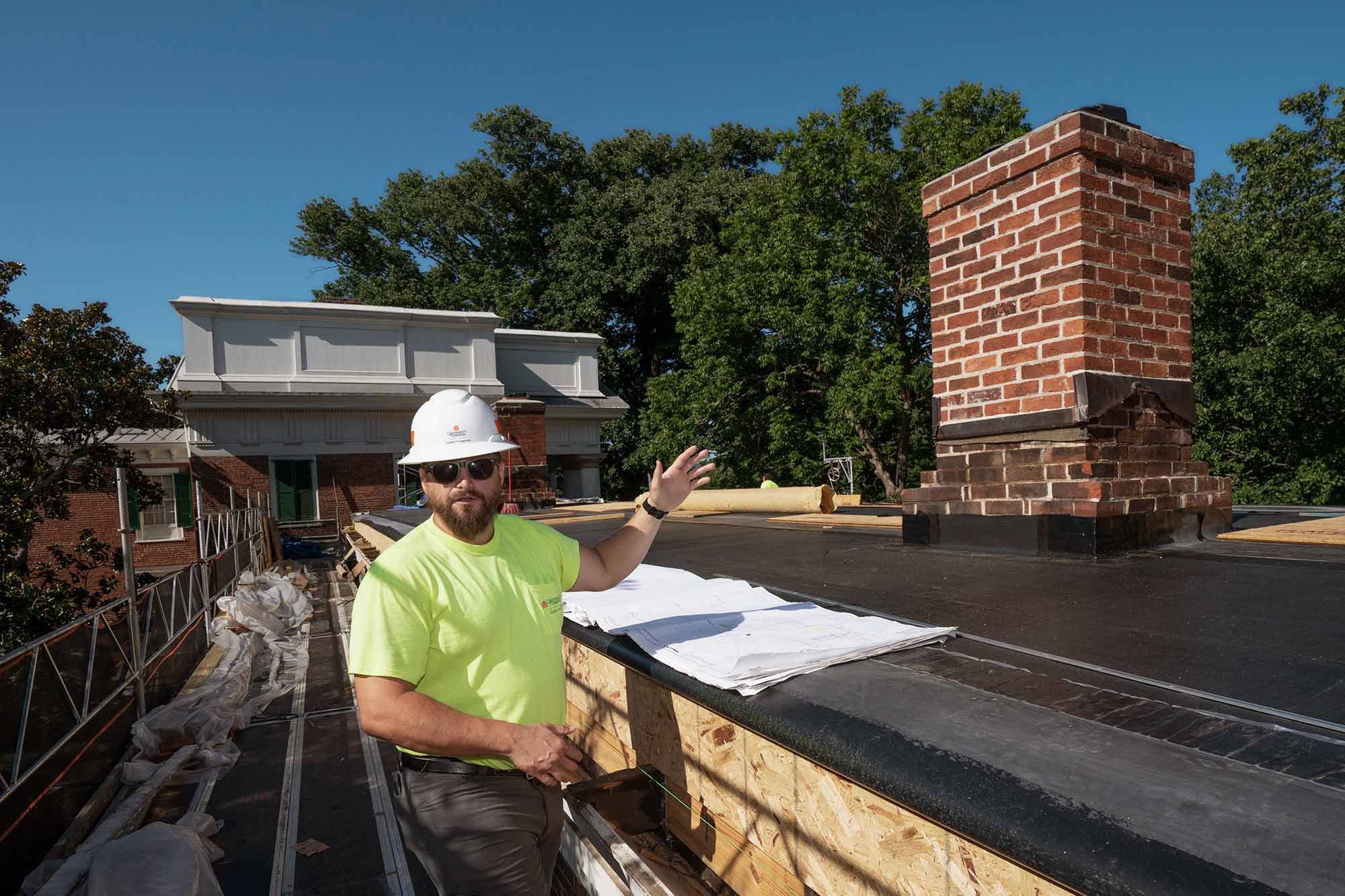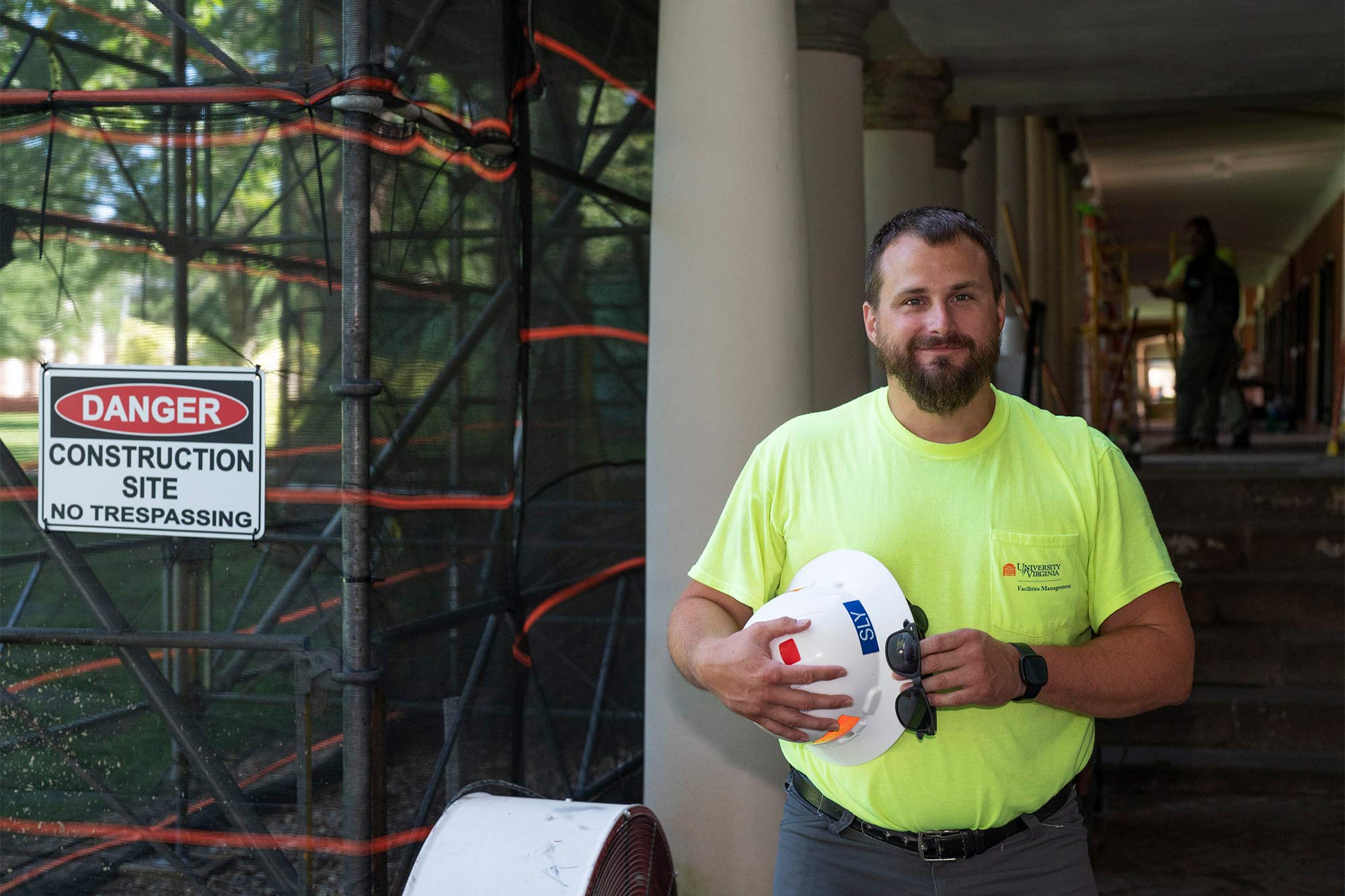Since the 1820s, the Academical Village, the centerpiece of the University of Virginia, has housed faculty and students. And since the beginning, there has been a succession of skilled workers (some of whom where enslaved) maintaining the property – masons, plasterers and carpenters who have worked with the historic fabric of UVA.
And because the Academical Village also is a World UNESCO Heritage Site, a rare distinction reserved only for culturally significant landmarks, maintaining the historic structures requires meticulous care.
As construction techniques evolved, the University advanced with the times while maintaining craftspeople skilled in the older ways. This summer, many of these skilled workers used their talents to replace the roof over the student rooms between pavilions VIII and X. They also built a chimney between rooms 48 and 50.
![] Mason and plasterer Tim Proffitt lays bricks by the fireplace in Lawn Room 48, while carpenter Andrew Shelton restores the room’s original closet. (Photo by Dan Addison, University Communications) Drew Shelton sits in front of a fireplace, replacing the brick hearth.](/sites/default/files/Inline_01_Lawn_Room_48_-_Drew_Shelton_-_Tim-Proffitt_01_DA.jpg)
A walnut closet, once relocated to room 50, was going back to its original spot in room 48. It would need readjustment, so carpenter Andrew Shelton carefully measured it. Behind him, Timothy Proffitt, dressed all in blue, slathered plaster on the outside of a newly constructed fireplace. He scarred the fresh plaster so the next layer would have something to which to adhere.
“We call that the scratch coat,” Proffitt said. “The next coat will be a brown coat, and that one will be semi-smooth. Then we will go over it with the finish coat.”
Proffitt, who used a lime-based plaster, knows how to blend the historic with the modern.
“With the lime, when you get to a finish, you can’t put any type of latex paints over it,” Proffitt said. “It has to be a lime paint so it will accept water and it will keep breathing.”
These paints, plasters and materials aren’t something you find in Home Depot. And the skills to use them aren’t learned in modern construction training. But Shelton says maintaining historic buildings appeals to him.
“It is easily the part of my job I enjoy the most,” Shelton said. “I appreciate the responsibility we have for taking care of it, and maintaining it the best we can, while making it fit the needs of the modern University. It is very humbling to realize I was touching material that had been there for 200 years.”
Travis Sly, a carpenter supervisor who has worked at the University for 12 years, has been replacing roofs over student rooms while preserving the original Jeffersonian serrated roofs underneath. Part of the attraction for Sly is the continuity with the past and an appreciation of his predecessors’ talents.

While skilled in modern masonry, Tim Proffitt prefers the historic work. (Photo by Dan Addison, University Communications)
“In some of the attics, you can see rafter cuts that they made with tools that were very basic compared to what we have now, but the quality was superior to what people put out now with modern power tools,” Sly said. He admires “the precision in their cuts and the attention to detail, and this is for framing or rough carpentry – not to mention trim, cornice work or actual finish carpentry work.”
Mark Kutney, an architectural conservator with Facilities Management, said it is important to have craftspeople working on the historic buildings who understand the differences between Jeffersonian construction and 1870s construction.
“If we lose this material, we can no longer critically study it,” he said. “There is a lot of value in the Academical Village, and we have a lot to still study.”
“It is an important place to preserve, and I love it, honestly,” Shelton said. “I am glad I was able to get on at UVA here.”
Shelton came to carpentry through a circuitous route, after first earning degrees in nutrition and philosophy.
“It became clear to me that I did not enjoy the work I had set myself up for,” Shelton said. “Unfortunately, it took me that long to find out.”
Shelton is from Charlottesville, where he started working for his uncle, who did historic preservation and renovation.
“It turned out I really enjoyed it,” he said.
After his uncle retired, Shelton signed up for UVA’s apprenticeship program as a carpenter. He graduated from the program in 2019.
Sly was already a carpenter, framing houses for a living, when he shifted to the University in 2010, without understanding how much construction there was at UVA. He worked several jobs before landing a temporary carpenter job.
“One of my first projects was behind Hotel E, renovating the deck on the rear of it,” he said. “I worked with lead carpenter Greg Bugg, who is now retired. My next historic project – I was still a temp carpenter – was the first roof-and-rail project between Pavilion IX and the Colonnade Club. And I have been on every one of the roof-and-rail projects.”

Andrew Shelton started on another career path, but found he enjoys carpentry. (Photo by Dan Addison, University Communications)
Proffitt, who has been a historic mason and plasterer at UVA for 18 years, had been a “modern” mason, but he prefers the restoration work he does now.
“I went from modern masonry to historic, and the difference is day and night,” he said. “I still enjoy what I do. I enjoy the work. And sometimes I think I am still working like a young man.”
While his work makes him feel young, Proffitt possesses old knowledge, such as using horsehair or goat hair as a binder in plaster that is being applied to a lath, or wood-slatted, wall.
After he had finished with the first layer of plaster for the chimney, Proffitt and historic mason Brent Ryder laid in the bricks in front of the fireplace. They slathered a layer of mortar in the frame, pressing the brick into place. Proffitt used a level to make sure the bricks were flush with the floor. He set the edge of a square on the brick and tapped the square’s edge with his trowel handle, eyeing the guide line to make sure the bricks stayed even.
As he does this work, Proffitt is cognizant of the masons who came before him.
“There is so much stuff you have to figure out on your own, but I am trying to be up to their standards,” he said.
Shelton also is conscious of his predecessors.
“Some of their work is really amazing,” he said. “They were doing it with hand tools, and you get mortice and tenon joints on these huge pieces of framing lumber that I would have a difficult time duplicating with power tools. It is real craftsmanship that I can only hope to emulate. And I have a lot of advantages they didn’t. It really is something.”
He cited a replaced beam in the roof work between Pavilions III and V where hand-cut boards had been pegged together and morticed and tenoned to replace the beam.
“There is definitely a feeling of camaraderie as far as what has been done in the past, seeing things that did work, things that didn’t work,” Sly said. “As far as Jefferson roofs, there are more things that didn’t work than what did work, but seeing the concept and the design is actually very rewarding.”

“The Academical Village is an amazingly special place,” said Donald E. Sundgren, associate vice president and chief facilities officer. “It is not only a UNESCO World Heritage Site, but it is still being used as it was designed to be used by University founder Thomas Jefferson, with students and professors living and learning together on the Lawn.
“Rather than being curated like a museum, it requires stewardship as an operating and ongoing facility. Our people who specialize in working on historic structures are highly skilled in their areas of expertise and also very committed, with a profound passion, to the preservation and perpetuation of this University.”
The buildings in the Academical Village, because of their pedigree, are important.
“There are several things that make them valuable, including their function, design and who built them and with what materials,” Kutney said. “It is important that these people know the difference between an 1820s nail and a 1920s nail, or lime mortar versus Portland mortar. The tradespeople need the background in these.”
“I have never been what I would call a history buff,” Sly said. “But it definitely opened my eyes to some things by working on some of these projects. And I have some new-found appreciation for the way they did things then and how they managed to do them with such skill and such quality without having the luxuries of the tools and the methods that we have today.”
Media Contact
University News Associate Office of University Communications
mkelly@virginia.edu (434) 924-7291
Article Information
August 21, 2025




